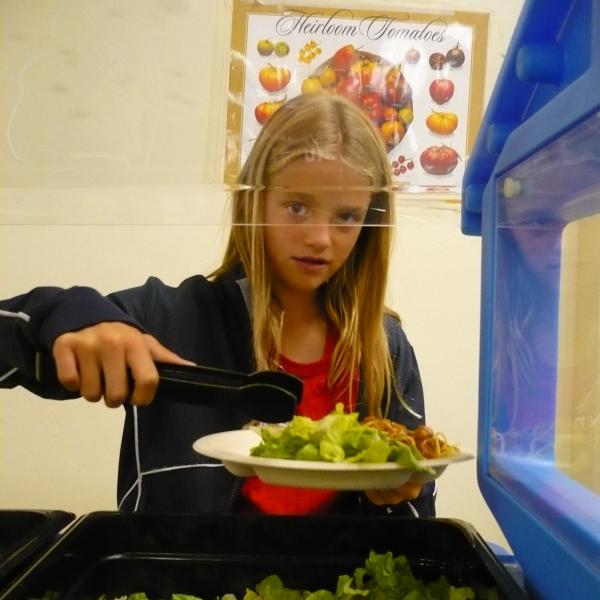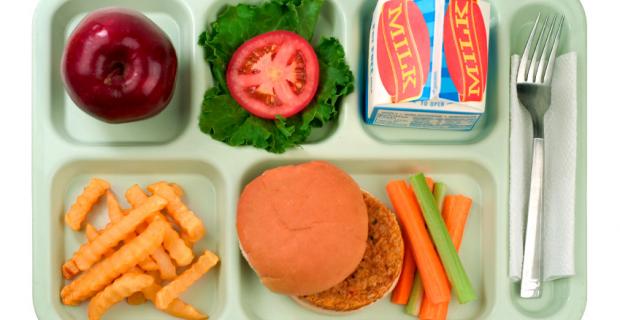Rethinking Lunchtime: How to Make School Meals an Integral Part of Education

Making Lunch an Integral Part of Education
In 2005, lunchtime at John Muir Elementary School in Berkeley, California, was not very different from school lunch periods across much of North America. The food was nondescript, greasy and calorie-heavy, often delivered in pre-processed, heat-and-serve "units" shipped from thousands of miles away in wrappings bearing corporate logos. For students, lunch was a detour on the way to their real noontime goal: the playground.
Eager to get to the lunch recess, many children rushed through their meals. Muir fifth-grade teacher Stephen Rutherford recalls that "children were claiming to be done with their lunch in five minutes and were leaving a huge amount of food waste bag lunches uneaten, and school lunches just tossed because their only mindset was to get out on the playground and have fun." The school had no system for waste management, Rutherford notes, so children would "pour their waste into this or that bin in an atmosphere of chaos and neglect."
Despite rushing through lunch, children were often left with as little as five or ten minutes to play (of the total 35 minutes allocated for lunch and recess), because so much time was lost as aides attempted to calm the children, establish order, and get them to the playground. For both teachers and students, lunchtime meant a break not only from the school day but also from each other. One Muir teacher described the noisy, rowdy lunchroom as "just not the place where you wanted to be." As in many other schools, tussling and shoving in the lunchroom often carried over into bullying on the playground and sometimes into classes afterward.
Lunchtime as education
Today, the situation has changed dramatically as a result of the school's decision to serve as a pilot school within the Berkeley School Lunch Initiative (SLI). A joint effort to design and implement curriculum and food service innovations in Berkeley public schools, the Berkeley SLI was launched in 2004 by the Berkeley Unified School District, the Chez Panisse Foundation and the Center for Ecoliteracy. The Muir community had generated various ideas for innovations, but many of them, such as radically redesigning the lunchroom or revamping the district food service, were determined to be too expensive or out of their control. They needed a starting place, something they could do that didn't require extra money but had high visibility and good prospects for early success.
During the 2004–2005 school year, the Center for Ecoliteracy offered a series of School Lunch Initiative workshops for Berkeley school administrators, faculty and staff. At one of the workshops, participants learned of research showing that students who eat lunch after recess behave better in the lunchroom, eat more and waste less than those who eat before recess.1 Muir teachers and administrators decided to reverse the order of lunch and recess, adding 10 minutes to the lunch period so that students would have 25 minutes of playground time followed by 20 minutes for lunch. "We acknowledged," one teacher observed, "that time to run around and interact and be physical is as crucial to the day as reading time." After exercising, and without the incentive to rush through their meals, children began to eat more and to throw away less.
Building on this structural change, the Muir staff went further to make the lunch period a teaching opportunity, thereby helping students see lunch as an educational part of their day. Muir teachers, who once shunned the dining hall, now eat there more often, and every teacher joins his or her class for the last ten minutes of lunch and supervises cleanup. The ten-minute period that teachers spend in the lunchroom is designated as instructional time, a precious commodity given pressures to devote increasingly more minutes to subjects covered in standardized tests.
The new schedule also initiated a series of less-expected changes. Faced with the push to meet testing mandates, many schools are reducing time for physical education and meals in spite of evidence that children who exercise and eat well are better prepared for learning. Now children at Muir spend both more time playing and more time eating than they did before. On the playground, supervisors report less fighting. Students return to class more ready to learn. One teacher told me, "I never have students coming back into the classroom angry and upset," as they did when they had only five or ten minutes to play.
Simply giving children more time to eat and converse over food is itself a way to cultivate habits and attitudes different from those engendered by a culture awash in fast food. "We need to give our children enough time to eat, sit, enjoy and socialize," says Ann Cooper, Berkeley's director of Nutrition Services. Under her leadership, the district food service has made decided improvements in the food served at BUSD schools: salad bars are now offered in every school, fresh fruits and vegetables are served daily, 95 percent of the processed foods are gone, most meals are made from scratch, and most of the ingredients are purchased locally.
From the first grade on, students learn to sort their lunch waste into gray bins ("recycling"), green bins ("compost"), and galvanized cans ("landfill"). These distinctions have become part of the students' vocabulary, lessons, and practice. Says a first-grade teacher, "Even the kids who bring lunch aren't just throwing things into the landfill. They're taking their little baggies back to reuse them." As a side benefit, the new system saves the school money by decreasing the amount of waste that must be hauled to the landfill.
Making this plan work required the cooperation of the full Muir staff, including custodians, playground and lunchroom aides, and others who would be affected by the changes. Planners went to considerable lengths to schedule meetings when the entire staff could come, and worked to get everyone, including parents, to the initial meetings. "If we hadn't done that," says Rutherford, "I don't think the staff would have weathered the program's rocky start, because, of course, our first plan needed tweaking, and tweaking really fast."
Staff and students were confronted with substantial new responsibilities in a system being designed on the fly. And not everyone in the school supported the changes. One teacher filed a complaint with the teachers' union over the plan to designate a portion of the lunch period as instructional time, necessitating a special agreement with the union. The "tweaking" took several months, but the staff stuck with the program because they had reached a consensus that the changes were important and had committed themselves to them.
The small lunchroom, with poor acoustics and tables lined up in long straight lines, presented a formidable barrier to comfortable conversation. Some teachers experimented with various alternatives, such as taking classes to the kitchen classroom adjacent to the lunchroom. This room was converted at lunchtime into a "cafe" with small round tables and tablecloths. Other classes have eaten in the garden or by a stretch of Harwood Creek, restored by parent volunteers, that runs through the campus. All the fifth-graders now eat with teacher Stephen Rutherford, seated at tables in the school's auditorium. Some bring bag lunches and some retrieve their lunch from the lunchroom, but all must wait for everyone to be ready before starting to eat.
Integrating food into the curriculum
The changes made to the lunch period at Muir build on the school's longtime commitment to hands-on experience. Every student, from kindergarten through fifth grade, spends time at least once every three weeks in a lovely instructional garden built by students in 2000. Students also meet twice a month in a cooking classroom. These gardening and cooking programs are supported by funds from the Network for a Healthy California, which channels federal nutrition education monies to schools where more than 50 percent of students qualify for National Lunch Program subsidies. School districts use the funds for a variety of purposes; Berkeley applies them to salaries for garden and cooking-classroom instructors.
In the garden, students help tend the soil, plant seeds, care for the plants, and then harvest their crops, which often become ingredients for seasonal dishes that they help prepare in the kitchen classroom. In both garden and kitchen, students learn where food comes from, about nutrition, natural cycles and processes, and the importance of conserving water and soil. They study such topics as regional and industrial food systems, while experiencing the pleasure of cooking, not to mention learning how to use sharp implements safely. Over and over, teachers and parents comment on their children's willingness to try unfamiliar foods that they themselves have grown and prepared, and their subsequent discovery that healthy food tastes good.
Classroom teachers use students' garden and kitchen experiences as a basis for teaching a variety of subjects, from math to history. After reversing lunch and recess, Muir teachers designed lessons into even the walk from the playground to the lunchroom. Children began with a ceremonial hand washing and followed a series of signs — "Cool Down"; "From Garden to Kitchen"; "From Kitchen to Lunchroom" — as they re-enacted the pathways that food follows. (This plan was revised in 2007, when the kitchen classroom moved from its small space next to the lunchroom to a "real" classroom, a larger space with white boards, flip charts, wall space, storage, and other amenities that reinforced its status in the curriculum).
Supported by seminars and professional development workshops offered through the Center for Ecoliteracy, teams from Muir have explored using food as a focus to integrate the curriculum across subjects and grades. For instance, a classroom teacher worked with the garden and cooking instructors to design a combined science/garden/cooking session taught in the school garden. The lesson allowed fourth- and fifth-grade students to experience the water web from three perspectives. With the garden instructor, they observed and felt water gushing through a branch cut from a banana tree in the garden. Rotating to a second station with a science teacher, they examined the flow of water through different types of soils. Finally, with the cooking instructor, they were reminded that their own bodies are part of the water web, as they sampled the juiciness of tomatoes harvested from the garden, then prepared and ate a simple tomato tapenade. These experiences enabled students to understand water flow in a more sophisticated way when their classroom teacher asked, "Where does the water in the banana tree, the soil and the tomato come from?" (For most of the California growing season, water does not come directly from rainfall the answer most children initially give. Rather, it is delivered through a complex water-channeling system whose design, history, and geography are part of fourth-grade curriculum.)
Not everything has gone smoothly at Muir, of course. Scheduling difficulties have limited the number of jointly taught sessions. The food served by the district food service has improved, but some students still bring sodas, sweets, and chips in homemade lunches. Dreams for remodeling the lunchroom to make it more appealing and conducive to informal discussions about food remain dreams. Schoolwide curricular change has also been slow, with some staff members embracing change more eagerly than others. Still, the major structural changes to the lunch period are now considered "just the way things are."
In 2007, the Center for Ecoliteracy secured a small grant to support preparations for implementing a curriculum that would more deeply integrate topics of food, health, culture, and the environment. When the project was introduced at a faculty meeting, more than half volunteered their own time to participate on the planning team. The priorities they set further reflected their commitment to the process: What concepts do kids need to understand? How can we make science and critical thinking a curricular umbrella, with food, culture, health, and the environment the content beneath it? What key concepts bridge science, social studies, and literature? How can we better connect curriculum across subject matter and grade levels? By what criteria can we measure schools' readiness to implement innovation?
Lessons learned
The experiences at John Muir Elementary suggest a number of lessons for teachers and administrators.
Schoolwide innovation requires a core group of committed faculty and staff.
When agreeing to become a pilot site for Berkeley School Lunch Initiative, the school staff realized that if they were going to succeed, the initiative had to become the John Muir School Lunch Initiative. Their efforts to reschedule planning times to permit participation by the whole staff proved critical.
Teachers can do only so much without administrative leadership and support.
According to Carolie Sly, former education program director at the Center for Ecoliteracy, principals can "lend legitimacy, validate the work, sanction it as a priority use of teachers' time, and help keep other pressures at bay for at least some planning and instructional time." Muir's participation in the School Lunch Initiative began when the principal learned about the program and, although it was summer vacation, phoned teachers to urge them to attend the first planning meeting.
Schools exist within "nested systems," and innovation requires effort at many levels.
Muir teachers needed cooperation from all of the Muir staff and from the district teachers' union. A single school has little control over the district food service, and efforts at many Berkeley schools foundered over the years until the district bolstered by its food policy, prodded by activists, and assisted by the Chez Panisse Foundation demonstrated its ability to improve the food throughout the district. Before that, says one teacher, "the mantra was, 'Why are we doing this? It's counterproductive. We teach children about healthy eating, and then they go down to lunch and get the chocolate milk and the hot dog.'" Many U.S. school districts expect food services to break even, if not make a profit. By contrast, the Berkeley school board has budgeted as much as $350,000 a year from general funds to subsidize the food service.
School districts are also nested within larger geographical and political systems. In the long run, maintaining Berkeley's commitment to better food in schools may hinge on local voters' willingness to increase their own taxes or to exert sufficient pressure on Congress to allocate funds for an adequate national lunch program. That pressure may emerge only when citizens recognize that school food is one part of a public health system whose downstream costs are borne by everyone.
Outside agencies can play significant roles.
The Center for Ecoliteracy not only designed professional development workshops and institutes, but also helped the district pay for substitute teachers, offered stipends to allow participation by Muir teams, and secured funding for facilitators to keep the process on track. The Rethinking School Lunch curricular framework designed by the Center relieved Muir teachers from having to identify which state standards could most readily be addressed in a curriculum oriented toward food. The Center's visual guide, "Linking Food, Culture, Health, and the Environment," helped define the pilot planning teams' objectives.
For schools to initiate change, what is most often needed is a first step that requires no new funding and no waiting for outside resources to appear. At John Muir Elementary School, the simple decision to reverse lunch and recess was that first step. As Stephen Rutherford explains, "the roadblock to change was only tradition, or what people might say can't be done."
This essay is adapted from Michael K. Stone, Smart by Nature: Schooling for Sustainability (Watershed Media/University of California Press, 2009).




